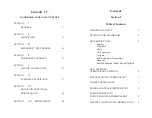
SECTION 4
CESSNA
NORMAL PROCEDURES
MODEL 172RG
STALLS
The stall characteristics are conventional and aural warning is
provided by a stall warning horn which sounds between 5 and 10 knots
above the stall in all configurations.
Power-off stall speeds at maximum weight for both forward and
aft
C.G. positions are presented in Section 5.
BEFORE LANDING
In view of the relatively low drag of the extended landing gear and the
high allowable gear operating speed (140 KIAS), the landing gear should
be extended before entering the traffic pattern. This practice will allow
more time to confirm that the landing gear is down and locked. As a further
precaution, leave the landing gear extended in go-around procedures or
traffic patterns for touch-and-go landings.
Landing gear extension can be detected by illumination of the gear
down indicator light (green), absence of a gear warning horn with the
throttle retarded below 12 inches of manifold pressure and/or the wing
flaps extended beyond 20°, and visual inspection of the main gear position.
Should the gear indicator light fail to illuminate, the light should be
checked for a burned-out bulb by pushing to test. A burned-out bulb can be
replaced in flight with the landing gear up (amber) indicator light.
LANDING
NORMAL LANDING
Landings should be made on the main wheels first to reduce the
landing speed and the subsequent need for braking in the landing roll. The
nose wheel is lowered gently to the runway after the speed has diminished
to avoid unnecessary nose gear load. This procedure is especially impor-
tant in rough field landings.
SHORT FIELD LANDING
For a short field landing over an obstacle, make a relatively steep, low-
power approach at 63 KIAS with 30° flaps. As the obstacle is cleared.
reduce power to idle, maintain 63 KIAS and flare to land on the main
wheels first. Immediately after touchdown, lower the nose gear to the
ground and apply heavy braking as required. For maximum brake
4-20
1 July 1979
CESSNA
SECTION 4
MODEL 172RG
NORMAL PROCEDURES
effectiveness after all three wheels are on the ground, retract the flaps, hold
full nose up elevator and apply maximum possible brake pressure without
sliding the tires.
CROSSWIND LANDING
When landing in a strong crosswind, use the minimum flap setting
required for the field length. Although the crab or combination method of
drift correction may be used, the wing-low method gives the best control.
After touchdown, hold a straight course with the steerable nose wheel and
occasional braking if necessary.
BALKED LANDING
In a balked landing (go-around) climb, the wing flap setting should be
reduced to 20° immediately after full power is applied. After all obstacles
are cleared and a safe altitude and airspeed are obtained, the wing flaps
should be retracted.
COLD WEATHER OPERATION
STARTING
Prior to starting on cold mornings, it is advisable to pull the propeller
through several times by hand to "break loose" or "limber" the oil, thus
conserving battery energy.
NOTE
When pulling the propeller through by hand, treat it as if
the ignition switch is turned on. A loose or broken ground
wire on either magneto could cause the engine to fire.
In extremely cold (-18° C and lower) weather, the use of an external pre-
heater and an external power source are recommended whenever possible
to obtain positive starting and to reduce wear and abuse to the engine and
the electrical system. Pre-heat will thaw the oil trapped in the oil cooler,
which probably will be congealed prior to starting in extremely cold
temperatures. When using an external power source, the position of the
master switch is important. Refer to Section 9, Supplements, for Ground
Service Plug Receptacle operating details.
Cold weather starting procedures are as follows:
1 July 1979
4-21








































